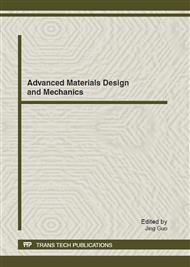[1]
A. Rogalski, Progress in Quantum Electronics, Vol. 27 (2003), p.59.
Google Scholar
[2]
D. H. Zhang and W. Shi, Appl. Phys. Lett. Vol. 73, (1998), p.1095.
Google Scholar
[3]
W. Shi. et al., J. Crys. Growth, Vol. 197, (1999) p.89.
Google Scholar
[4]
D. H. Zhang, X. Z. Wang, H. Q. Zheng, S. F. Yoon and C. H. Kam, J. Vac. Sci. & Technol., B18, (2000), p.2274.
Google Scholar
[5]
D. H. Zhang, Shi W. Shi, H. Q. Zheng et al. J. Crys. Growth, Vol. 211, (2000) p.384.
Google Scholar
[6]
D. H. Zhang, Materials Science and Engineering B-Solid State Materials for Advanced Technology, Vol. 60, (1999), p.189.
Google Scholar
[7]
D. H. Zhang, C. Y. Li and S. F. Yoon, J. Crys. Growth, Vol. 181, (1997), p.1.
Google Scholar
[8]
D. H. Zhang, K. Radhakrishnan and S. F. Yoon, J. Crystal Growth, Vol. 148, (1995), p.35.
Google Scholar
[9]
D. H. Zhang, Y. Gao, Y., J. Wei, Z.Q. Mo, Z. Q, Thin Solid Films, Vol. 377-378, (2000) p.607.
Google Scholar
[10]
Y. Gao, et al., Thin Solid Films, Vol. 377-378, (2000) p.562.
Google Scholar
[11]
C. Y Li et al., Surface Review Letters, Vol. 8(5), (2001) p.459.
Google Scholar
[12]
L.Y. Yang et al., Thin Solid Films, Vol. 462, (2004) p.176.
Google Scholar
[13]
D. H. Zhang, W. Liu, L. Sun, W.J. Fan, S.F. Yoon and S.Z. Wang, J. Appl. Phys., Vol. 99 (2006), p. (043514), 1-4.
Google Scholar
[14]
O. Nesher, S. Elkind, I. Nevo, T. Markovitz, A. Ganany, A. B. Marhashev, I. Fisher, M. Kenan and M. B. Ezra, Proc. Infrared Technology and Applications XXX, SPIE 5406, 214 (2004).
DOI: 10.1117/12.544508
Google Scholar
[15]
T. Ashley, T. M. Burke, G. J. Pryce, A. R. Adams, A. Andreev, B. N. Murdin, E. P. O'Reilly and C. R. Pidgeon, Solid-State Elec. Vol. 47 (2003) p.387.
DOI: 10.1016/s0038-1101(02)00377-5
Google Scholar
[16]
D. H. Zhang, W. Liu, Y. Wang, X. Z. Chen, J. H. Li, Z. M. Huang and S. S. Y. Zhang, Appl. Phys. Lett. Vol. 93 (2008), p.131107.
Google Scholar
[17]
X. Z. Chen, D. H. Zhang, W. Liu, Y. Wang, J.H. Li, A.T.S. Wee and A. Ramam, Electronics Letters, Vol. 46, No. 11 (2010), p.787.
Google Scholar
[18]
I. Mahboob, T. D. Veal and C. F. McConville, J. Appl. Phys. Vol. 96 (2004), p.4935.
Google Scholar
[19]
J. R. Soderstrom, M. M. Cumming, J-Y Yao and T. G. Andersson, Semicond. Sci. Technol. Vol. 7, (1992), p.337.
Google Scholar
[20]
J. J. Hopfield, D. G. Thomas, and R. T. Lynch, Phys. Rev. Lett. Vol. 17 (1966), p.312.
Google Scholar
[21]
K. M. Yu, W. Walukiewicz, J. Wu, D. E. Mars, D. R. Chamberlin, M. A. Scarpulla, O. D. Dubon, and J. F. Geisz, Nat. Mater. Vol. 1 (2002), p.185.
DOI: 10.1038/nmat754
Google Scholar


